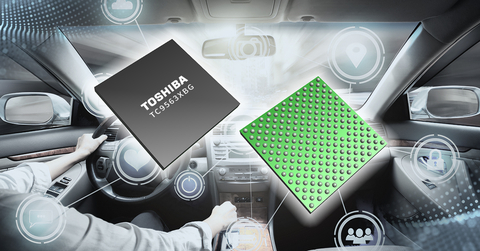– Equipped with two 10Gbps Ethernet AVB/TSN ports and three PCIe® Gen 3 switch ports –
KAWASAKI, Japan — (BUSINESS WIRE) — January 11, 2022 — Toshiba Electronic Devices & Storage Corporation ("Toshiba") has added “ TC9563XBG” to its line-up of Ethernet bridge ICs, to provide support for 10Gbps communications in automotive information communications systems and industrial equipment. Sample shipments have started and volume production will start in August 2022.
This press release features multimedia. View the full release here: https://www.businesswire.com/news/home/20220111005566/en/

Toshiba: an Ethernet bridge IC “TC9563XBG” which provides support for 10Gbps communications in automotive information communications systems and industrial equipment. (Graphic: Business Wire)
Automotive networks are evolving toward zone architecture[1], where communications between zones use real-time, multi-gig[2] transmission via Ethernet at a rate of 1Gbps or higher. The new bridge IC has Toshiba’s first 2-port 10Gbps Ethernet, and the interface can be selected from USXGMII, XFI, SGMII, and RGMII[3]. The two ports support Ethernet AVB[4] and TSN[5], which facilitate real-time processing and synchronous processing, respectively. They also support “simplified” SR-IOV (virtual functions)[6]. The combination of these features in the new product delivers solutions suited to next-generation automotive networks.
As the speeds of communications devices continue to increase, the new IC can be used not only for zone architecture but also for various automotive applications such as IVI and telematics, and also in industrial equipment. It is also postioned to be a successor to current TC9560 and TC9562 series products supporting 1Gbps Ethernet.
In recent years, more and more devices have been equipped with PCIe interfaces for device-to-device communications, such as Wi-Fi®, and the host SoC tends to run short of PCIe interfaces. TC9563XBG has three PCIe Gen 3 switch ports for communications with the host SoC and connection to devices equipped with PCIe interfaces. The PCIe switch part is configured with one 4-lane upstream port for connection with the host SoC and two 1-lane downstream ports for connection to devices with a PCIe interface. Using the 3-port PCIe switch function for connections to such devices can help mitigate PCIe interface shortages.
TC9563XBG will be AEC-Q100 Grade 3[7] qualified.
Notes:
[1] Zone architecture: A network configuration expected to be used for next generation automotive networks, in which a vehicle is divided into multiple zones that communicate with each other at high speeds for collaborative operation.
[2] Multi-gig: Multi-Gigabit Ethernet (2.5Gbps to 10Gbps). Recent automotive networks require a bandwidth larger than 1Gbps.
[3] USXGMII, XFI, SGMII, RGMII: Standards for Ethernet interfaces. USXGMII = Universal Serial 10 Gigabit Media Independent Interface; XFI = 10 Gigabit serial Interface; SGMII = Serial Gigabit Media Independent Interface; RGMII = Reduced Gigabit Media Independent Interface.
[4] Ethernet AVB: IEEE802.1 Audio/Video Bridging. A standard for handling audio and video data using Ethernet standard technology.
[5] Ethernet TSN: IEEE802.1 Time-Sensitive Networking. A standard for data transmission with lower latency than AVB.
[6] SR-IOV: Single Root I/O Virtualization. A standard that supports virtualization on PCI devices.
[7] AEC-Q100 Grade 3: Test standards formulated by the automotive industry for certifying reliability of ICs.
Applications
- Automotive infotainment
- Automotive telematics
- Automotive gateways
- Industrial equipment
Features
- 2 10Gbps Ethernet ports (selectable from USXGMII, XFI, SGMII or RGMII)
- 3 PCIe Gen3 switch ports
- To be AEC-Q100 Grade 3 qualified.
Main Specifications
Part number |
|
CPU Core |
Arm® Cortex®-M3 |
HOST (external
|
PCIe I/F: Gen3.0(8GT/s) 3 ports switch Upstream: 1 port × 4 lanes Downstream: 2 ports each x1 lane
Supports low power states of L0s, L1 and L1 PM substate as power management
Simplified SR-IOV (virtual function) available |
Automotive interfaces |
Ethernet AVB, built-in MAC with TSN support (2 ports)
Supported interfaces are: PortA: Selectable from USXGMII, XFI, and SGMII PortB: Selectable from USXGMII, XFI, SGMII, and RGMII
Communication speed is: If USXGMII is selected: 2.5G/5G/10Gbps If XFI is selected: 10M/100M/1000M/2.5G/5G/10Gbps If SGMII is selected: 10M/100M/1000M/2.5Gbps If RGMII is selected: 10M/100M/1000Mbps |
Peripheral interfaces |
|
Supply voltage |
Selectable from 1.8V/3.3V (IO) 1.8V (USXGMII/XFI/SGMII/RGMII) 1.8V (PCIe, PLL, OSC) 0.9V (Core) |
Package |
P-FBGA 220 balls, 10mmx10mm, 0.65mm pitch |
See the URL below for further details on the new product.
TC9563XBG
See the URL below for more on Toshiba’s Automotive Ethernet Bridge ICs.
Automotive Ethernet Bridge ICs
* Arm and Cortex are registered trademarks of Arm limited (or its subsidiaries) in the US and/or elsewhere.
* Wi-Fi is a registered trademark of Wi-Fi Alliance.
* PCIe® and PCI Express® are registered trademarks of PCI-SIG.
* Other Company names, product names, and service names may be trademarks of their respective companies.
Customer Inquiries
MCU & Digital Device Sales & Marketing Dept.
Contact Us
* Information in this document, including product prices and specifications, content of services and contact information, is current on the date of the announcement but is subject to change without prior notice.
About Toshiba Electronic Devices & Storage Corporation
Toshiba Electronic Devices & Storage Corporation, a leading supplier of advanced semiconductor and storage solutions, draws on over half a century of experience and innovation to offer customers and business partners outstanding discrete semiconductors, system LSIs and HDD products.








